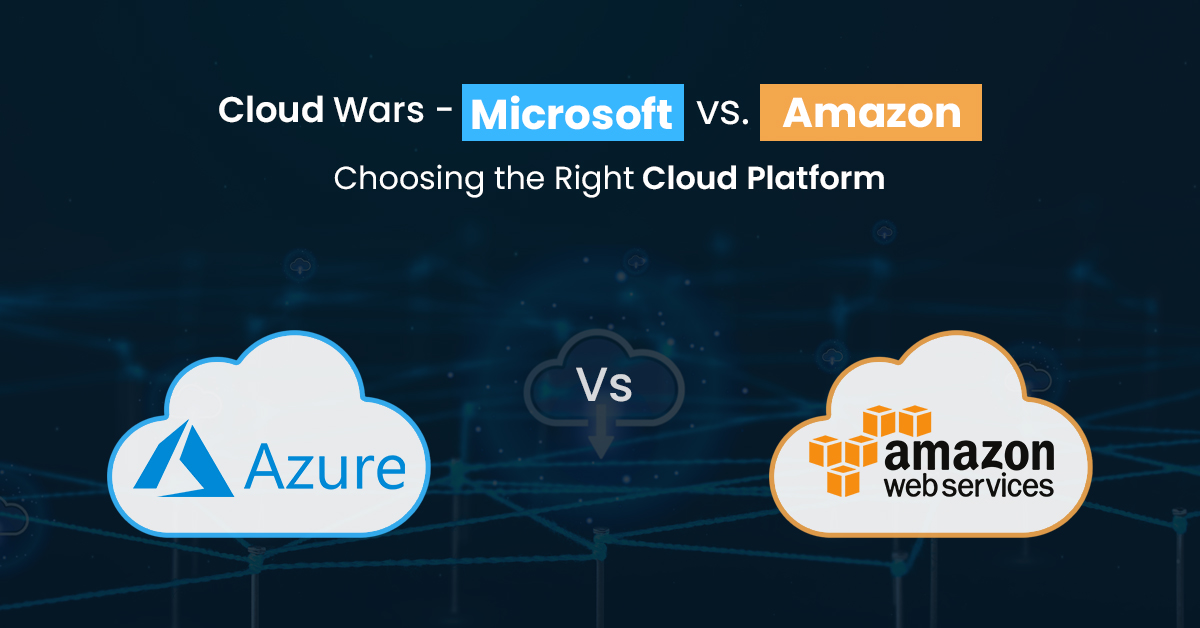Cloud Wars - Microsoft vs. Amazon: Choosing the Right Cloud Platform
In the highly competitive world of cloud computing, two giants stand out: Microsoft and Amazon. This blog delves into the details of their respective cloud platforms, Azure and Amazon Web Services (AWS), and compares them in terms of pricing, performance, security, and service offerings. With unique advantages offered by each platform, the choice ultimately depends on your business needs. Discover the game-changing potential of cloud technology and make an informed decision for your business.
Table of Contents
Share the article with your friends
In today’s digital age, cloud computing has become a game-changer for almost every business. It has revolutionized how organizations operate with cloud technology solutions that offer flexibility, scalability, and cost-effectiveness.
However, while the allure of cloud based technology is undeniable, it’s important to acknowledge the highly competitive nature of the market. Tech powerhouses such as Google, IBM, Amazon, and Microsoft fiercely compete for dominance and strive to secure the leading position.
Each of these cloud technology companies offers unique advantages. But for now, let’s zoom in on the two dominant giants in this space: Microsoft and Amazon. Before we delve into the details, here’s a brief explanation of what cloud computing is.
Understanding Cloud Computing
Cloud computing refers to delivering computing services over the internet, eliminating the need for local servers or personal computers. It allows businesses to leverage remote servers, storage, and services to streamline their operations and drive innovation.
Microsoft’s Azure and Amazon’s Amazon Web Services are two of the most commonly used cloud based technology platforms. Let’s have a look at them.
Microsoft’s Cloud Platform – Azure
Microsoft Azure is a comprehensive cloud platform that offers a broad spectrum of cloud technology solutions. From virtual machines and storage to databases and artificial intelligence, Azure provides businesses with the tools they need to build, deploy, and manage applications seamlessly.
With its robust infrastructure and seamless integration with Microsoft’s suite of productivity tools, Azure empowers organizations to harness the full potential of cloud computing. Businesses can build, deploy, and manage applications across a global network of data centers. Therefore, making it a preferred choice for many enterprises.
Amazon’s Cloud Platform – AWS
Amazon Web Services (AWS), on the other hand, offer its own unique set of services and solutions. AWS provides businesses with a highly scalable and reliable platform, encompassing storage, databases, analytics, and machine learning.
With its global infrastructure, extensive partner network, and focus on innovation, AWS has established itself as a frontrunner in the cloud computing landscape.
So, which one should you choose? Let’s have a look at both of them in detail.
Microsoft vs. Amazon
When comparing Azure and AWS, several factors come into play. Pricing and cost considerations, performance and scalability, security and compliance, and service offerings are crucial in decision-making. Both platforms have their strengths and weaknesses, and the choice ultimately depends on your business needs.
Pricing and Cost Considerations
Pricing and cost considerations are of paramount importance. Azure and AWS employ different pricing models, and businesses must evaluate their usage patterns and requirements to determine the most cost-effective option.
It’s important to consider factors such as on-demand vs. reserved instances, data transfer costs, and storage fees when comparing the pricing structures. For example, both Azure and AWS offer the flexibility of on-demand instances, where businesses pay for the computing resources they use on an hourly or per-minute basis.
However, they also provide the option of reserved instances, which involve committing to a specific instance type and duration in exchange for discounted pricing. Similarly, Azure and AWS have different pricing structures for data transfer, including inbound and outbound data transfer.
Performance and Scalability
Moving forward, let’s not forget that performance and scalability are crucial aspects of cloud technology. Businesses rely on cloud platforms to deliver fast and efficient services to their users. Both Azure and AWS offer robust infrastructure and tools to optimize performance and achieve scalability.
However, factors such as network latency, availability zones, and auto-scaling capabilities should be considered when evaluating the performance of each platform. Here’s a detailed explanation.
Network Latency
Network latency refers to the time it takes for data to travel between a user’s device and the cloud server. Low network latency is crucial for delivering fast and responsive services. Both Azure and AWS have a vast global infrastructure with data centers strategically located worldwide, reducing network latency for users.
For instance, AWS has a network of availability zones, enabling businesses to deploy their applications in geographically diverse locations to minimize latency and improve performance.
According to Cedexis’ 2020 State of the Cloud report, both Azure and AWS demonstrated low latency across various regions, indicating their commitment to providing high-performance services to users.
Availability Zones
Moreover, availability zones (AZs) are physically separate data centers within a region, each with independent power, cooling, and networking. They offer redundancy and fault tolerance, allowing businesses to achieve high availability and resilience. Azure and AWS both provide multiple availability zones within their regions.
Azure offers a Service Level Agreement (SLA) for virtual machines of at least 99.9% availability when deployed in multiple availability zones. Similarly, AWS offers a similar SLA for services deployed in multiple availability zones, ensuring high availability and minimizing the risk of downtime.
Auto-Scaling Capabilities
Last but not the least, auto-scaling is a critical feature that allows cloud platforms to automatically adjust resources based on workload demand. It ensures that businesses have the necessary resources available during peak periods and scales down during low-traffic times, optimizing cost-efficiency.
Both Azure and AWS provide robust auto-scaling capabilities. Azure offers services like Azure Autoscale, which enables automatic scaling based on predefined metrics. AWS provides Auto Scaling, which allows businesses to scale resources such as EC2 instances, ECS tasks, and DynamoDB tables based on demand.
Security and Compliance
Security is a top priority in the cloud environment. Azure and AWS have implemented stringent security measures and certifications to protect customer data. Encryption, identity and access management, and compliance frameworks are key aspects to consider when assessing the security posture of each platform.
In this case, Azure adheres to a robust security framework. It has achieved various industry certifications, including ISO 27001, SOC 1 and SOC 2, HIPAA, and GDPR compliance. Azure offers built-in encryption at rest and in transit, ensuring that data remains secure throughout its lifecycle. Additionally, Azure provides a comprehensive identity and access management system, enabling businesses to manage user permissions and control access to their cloud resources.
On the other hand, AWS has also obtained certifications such as ISO 27001, SOC 1 and SOC 2, PCI DSS Level 1, and HIPAA compliance. AWS offers multiple encryption options, including server-side and client-side encryption, to protect data stored in its infrastructure. Identity and Access Management (IAM) is a core component of AWS, allowing organizations to define granular access policies and manage user identities effectively.
Service Offerings
Lastly, the breadth and depth of service offerings are essential considerations when choosing a cloud platform. Azure and AWS provide various services, including computing, storage, networking, analytics, and machine learning.
Understanding each platform’s specific services and their respective strengths and weaknesses in those areas can help businesses align their requirements with the right cloud provider. To help you grasp the concept better, let’s have a look at each of these factors in detail.
Computing Services
Azure offers services like Azure Virtual Machines, Azure Container Instances, and Azure Functions, providing flexible options for running applications and workloads. AWS provides Amazon EC2, Amazon ECS, and AWS Lambda for compute capabilities. Understanding the specific features, pricing models, and performance characteristics of these services can help businesses select the appropriate platform for their computing needs.
Storage Services
Both Azure and AWS offer various storage options, including object storage, file storage, and block storage. Azure provides services like Azure Blob Storage, Azure Files, and Azure Disk Storage, while AWS offers Amazon S3, Amazon EFS, and Amazon EBS. Businesses should evaluate factors such as durability, scalability, and cost efficiency to determine which platform aligns better with their storage requirements.
Networking Services
Azure and AWS provide networking services to facilitate connectivity and security within the cloud environment. Azure offers services like Azure Virtual Network, Azure Load Balancer, and Azure ExpressRoute, while AWS provides Amazon VPC, Elastic Load Balancing, and AWS Direct Connect. Understanding the networking capabilities and features of each platform enables businesses to make informed decisions based on their specific networking needs.
Analytics and Machine Learning Services
Both Azure and AWS offer a wide range of analytics and machine learning services to derive insights from data. Azure provides services like Azure Synapse Analytics, Azure Machine Learning, and Azure Cognitive Services. AWS offers Amazon Redshift, Amazon SageMaker, and AWS AI services. Evaluating the capabilities, ease of use, and integration with existing workflows can help businesses identify the platform that best suits their analytics and machine learning requirements.
Case Studies
Feeling intrigued yeah? Well, let’s explore real-world case studies that offer valuable insights into how organizations from various industries have utilized both of these cloud platforms.
Starting with AWS, one of the most notable examples of successful utilization of AWS is Netflix. It began migrating its infrastructure to AWS in 2008 and completed the transition by 2016. This allowed Netflix to effectively manage the tremendous amount of data and traffic its millions of subscribers generated.
Netflix relied on AWS’s Elastic Load Balancing service to distribute incoming traffic across multiple instances, ensuring excellent availability and fault tolerance. AWS’s data storage services, including Amazon S3 and Amazon DynamoDB, played a crucial role for Netflix, enabling efficient storage and retrieval of extensive customer data, such as user preferences and viewing history.
Interestingly, Netflix itself expressed its satisfaction with AWS, emphasizing its ability to rapidly scale infrastructure and handle high traffic loads during peak times, such as the release of popular shows or movies.
Similarly, Siemens turned to Microsoft Azure to advance its digital transformation initiatives. Azure’s cloud services empowered Siemens to develop and deploy various applications, improve operational efficiency, and leverage data analytics for informed decision-making.
Siemens capitalized on Azure Machine Learning to create predictive models and optimize manufacturing processes. This resulted in increased productivity and significant cost savings for the company. In addition to this, the company benefited from Azure’s global presence and compliance certifications, which were essential for their operations across multiple regions with stringent regulatory requirements.
According to a Microsoft case study, Siemens attributed its success in predictive maintenance and reduced downtime to Azure’s IoT services. By connecting and monitoring its industrial machinery through Azure, Siemens achieved better maintenance planning and enhanced operational performance.
These real-world case studies exemplify how organizations like Netflix and Siemens harnessed the capabilities of AWS and Azure, respectively, to accomplish their business objectives.
Future Outlook
The cloud computing landscape is constantly evolving, with Microsoft and Amazon continuously innovating and introducing new features and services. Keeping an eye on the future roadmap of both these platforms can help businesses anticipate upcoming advancements and align their long-term cloud strategies accordingly.
Here is a comprehensive overview of the future outlook for both Microsoft Azure and Amazon Web Services (AWS).
Azure’s Future Outlook
Microsoft Azure has demonstrated a strong commitment to innovation and has consistently expanded its services and capabilities. Several factors indicate a positive future outlook for Azure.

Growing Market Dominance
Azure has experienced significant growth and currently holds a substantial market share in the cloud computing industry. According to the 2020 Gartner report, Azure was ranked as the second-largest cloud provider worldwide, with a 19.7% market share.
Continual Investment in Research and Development
Microsoft has a robust research and development division that focuses on cloud technologies. The company allocates a significant portion of its budget to drive innovation and enhance Azure’s capabilities. In fiscal year 2021, Microsoft reported investing $19.1 billion in research and development, supporting future advancements in Azure.
Azure Arc and Hybrid Cloud Solutions
Azure has been actively expanding its hybrid cloud offerings, allowing businesses to seamlessly connect and manage both on-premises and cloud-based resources. Azure Arc, introduced in 2019, enables customers to extend Azure services and management capabilities to any infrastructure. This indicates Microsoft’s commitment to providing versatile solutions that meet evolving business needs.
Quantum Computing Initiatives
Microsoft has made notable investments in quantum computing research and development, with the aim of bringing quantum computing capabilities to Azure in the future. The company’s quantum computing platform, Azure Quantum, is already available for early access, demonstrating Microsoft’s long-term vision for advanced computing technologies.
AWS’s Future Outlook
Amazon Web Services (AWS) has been a dominant player in the cloud computing market, and its future outlook remains promising. Here’s why

Unmatched Market Position
AWS has consistently held the largest market share in the cloud computing industry. According to the 2020 Gartner report, AWS secured the top position with a 41.5% market share, indicating its strong market presence and customer adoption.
Expanding Service Portfolio
AWS has an extensive range of cloud services, spanning computing, storage, databases, analytics, AI, and more. The company consistently introduces new services and updates existing ones to address emerging trends and customer demands.
For example, AWS offers services like Amazon SageMaker for machine learning and AWS Lambda for serverless computing, reflecting its commitment to innovation.
Focus on Artificial Intelligence and Machine Learning
AWS has been investing heavily in artificial intelligence (AI) and machine learning (ML) capabilities, providing a comprehensive suite of services in this domain. With services like Amazon Rekognition, Amazon Comprehend, and Amazon Forecast, AWS aims to enable businesses to leverage AI and ML technologies easily.
Continued Data Center Expansion
AWS continues to expand its global infrastructure to enhance performance and reduce latency for customers worldwide. The company frequently announces the opening of new data centers and regions, which demonstrates its commitment to improving availability and scalability.
However, it’s important to note that the future outlook for both these cloud technology companies is subject to the competitive landscape and technological advancements. While at present, their future outlook seems a positive one, businesses should continuously monitor and adapt their cloud strategies based on changing industry trends and their specific requirements.
How Can Appricot IT Consultants help?
We at Appricot IT Consultants have a team of experienced professionals with in-depth knowledge and expertise in Microsoft Azure and AWS. What sets us apart from the competition is that we comprehensively assess a business’s specific requirements, objectives, and existing IT infrastructure.
In addition to this, we analyze factors such as workload types, scalability needs, security requirements, and budget considerations to determine which cloud platform best aligns with the business’s goals and constraints. Based on the assessment and analysis, we develop a customized cloud strategy that outlines the optimal approach for leveraging Azure or AWS.
Moreover, we provide end-to-end support during the migration and implementation process while identifying areas for improvement, recommending optimizations, and implementing cost-saving measures, allowing businesses to maximize their return on investment (ROI) and maintain peak operational efficiency.
Conclusion
Conclusively, both Microsoft and Amazon offer robust and feature-rich cloud platforms that cater to diverse business needs. When choosing between the both, businesses must carefully evaluate factors such as pricing, performance, security, and service offerings to make an informed decision.
Where Azure stands out with its seamless integration with Microsoft’s ecosystem and strong enterprise-grade capabilities, AWS excels in its extensive partner network, vast service portfolio, and emphasis on innovation. Ultimately, the choice between Azure and AWS depends on each organization’s unique requirements and objectives.
FAQs
Is Azure or AWS better for small businesses?
The choice between Azure and AWS for small businesses depends on factors such as budget, specific needs, and existing technology stack. Both platforms offer services suitable for small businesses, but it’s essential to evaluate their pricing, scalability, and support options to determine the best fit.
Can I use Azure and AWS together?
Yes, businesses can leverage a multi-cloud approach by using both Azure and AWS together. This strategy allows organizations to take advantage of the unique strengths and services offered by each platform, achieving greater flexibility and avoiding vendor lock-in.
Which cloud platform is more cost-effective?
The cost-effectiveness of Azure and AWS depends on individual usage patterns and requirements. It’s crucial to carefully analyze pricing structures, consider reserved instances, and estimate data transfer and storage costs to determine the most cost-effective option for your specific use case.
Are Azure and AWS secure?
Both Azure and AWS prioritize security and offer a wide range of security features and certifications. However, ensuring the security of your cloud environment also depends on implementing best practices, strong access controls, and following proper security protocols.
Can I migrate my existing applications to Azure or AWS?
Yes, both Azure and AWS provide tools and services to facilitate application migration. Whether you choose Azure or AWS, a well-planned migration strategy, including thorough testing and implementation, is essential for a successful transition.
Share the article with your friends
At Appricot IT Consultants
We’re driven by our passion for providing top-tier tech solutions to our clients. Our goal is to ensure that your business thrives in the digital age. Join us on a thrilling journey of innovation and growth, as we work together to unleash the full potential of your enterprise.
Related Articles
Satisfy your cravings for knowledge and inspiration!

Cloud Wars - Microsoft vs. Amazon
Learn about the features and benefits of Microsoft Azure and Amazon Web Services, two leading cloud platforms, to understand how to choose the one that best fits your needs

App Development Trends Shaping Real Estate Industry
From virtual and augmented reality to blockchain and smart contracts, discover the top 10 proptech app development trends that are shaping the future of the real estate industry.

Key Technologies Powering the Metaverse
Explore how top-tier technologies, such as blockchain, cryptocurrency, and NFTs, intertwine to create Metaverse, and how you can benefit from the opportunities they offer
